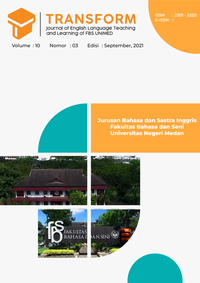Metaphor on Tanggap Wacana Panyandra in Panggih Manten Ceremony of the Java Ethnic Group
DOI:
https://doi.org/10.24114/tj.v10i3.44106Keywords:
metaphor, Panyandra Panggih Manten, semanticsAbstract
This study was aimed at identifying the types of metaphors contained in Panyandra Panggih Manten Ceremony of Javanese ethnicity. And the meaning contained in the metaphor. This study was conducted by applying descriptive qualitative method. The source of data was taken from the documentary transcription from recording the wedding ceremony event. The results of this research showed that written text can be analyzed by using metaphor. From that findings of the analysis conducted, there are 20 metaphorical units in the Javanese traditional wedding ceremony Panyandra, and have fulfilled all the categories by Crystal, Beckson and Ganz theory. Placing the conceptual metaphor category as the highest percentage category of 60% (12 units), next is the mixed metaphor category with a percentage of 15% (3 units), then the poetic metaphor category with the lowest percentage result with 25% (5 units).Downloads
Published
2023-03-14
Issue
Section
Articles
License
Copyright (c) 2023 Adelia Fitri Sabrina, Amrin Saragih

This work is licensed under a Creative Commons Attribution-ShareAlike 4.0 International License.
Authors who publish with this journal agree with the following terms:
- Authors retain copyright and grant the journal right of first publication with the work simultaneously licensed under a Creative Commons Attribution License that allows others to share the work with an acknowledgment of the work's authorship and initial publication in this journal.
- Authors are able to enter into separate, additional contractual arrangements for the non-exclusive distribution of the journal's published version of the work (e.g., post it to an institutional repository or publish it in a book), with an acknowledgment of its initial publication in this journal.
- Authors are permitted and encouraged to post their work online (e.g., in institutional repositories or on their website) prior to and during the submission process, as it can lead to productive exchanges, as well as earlier and greater citation of published work (See The Effect of Open Access).
- This work is licensed under a Creative Commons Attribution-ShareAlike 4.0 International License.

This work is licensed under a Creative Commons Attribution-NonCommercial-ShareAlike 4.0 International License.



